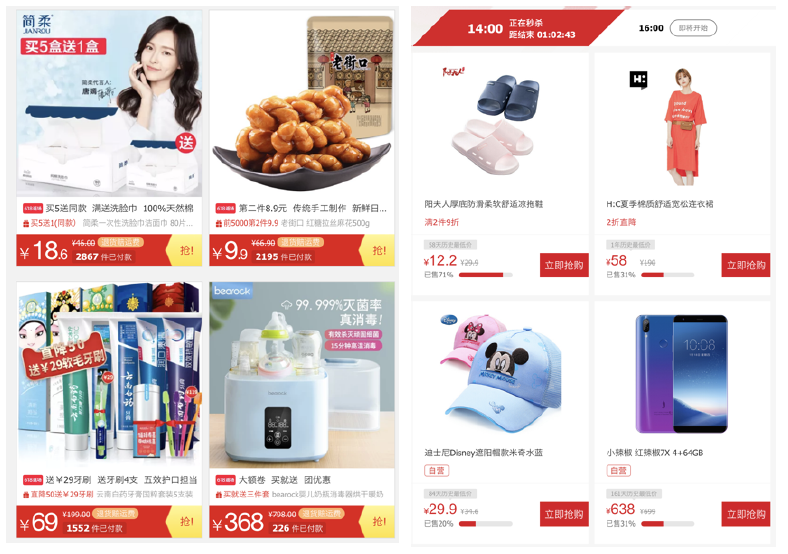
albert Chan
If Alibaba’s Singles’ Day is New York City, having grown into the largest online shopping festival in the world and eclipsing Black Friday, the 6.18 (June 18) shopping festival is Chicago: A second city working hard to catch up. Last year, Singles Day generated US$30.8 billion in sales, a 27% increase over 2017 – but only slightly ahead of JD.com’s 6.18 sales of $29.2 billion in 2019. JD.com launched the shopping event to commemorate the company’s founding date, June 18, 2010.
JD.com’s 6.18 festival has grown to become a major e-commerce event in China, with other e-commerce platforms also joining and reporting solid results — including rivals Alibaba-owned Tmall and group buying platform Pinduoduo.
E-Commerce Platforms All Report Winning Results During 6.18 Shopping Festival
JD.com saw total transaction volume of ¥201.5 billion (around $29.2 billion) from June 1 to 18, 26.6% higher than last year. By 8:00 pm on June 18, sales of mobile phones had increased 357% year over year, with books gaining 525% and beauty and skin care growing 412%.
Tmall has not yet revealed total transaction volume, but did disclose that more than 100 brands surpassed their Singles’ Day sales records, including Budweiser, Casio, Crocs, Godiva and L’Oréal. The platform also reported 110 brands reached ¥100 million (around $14.5 million) in sales, including Apple, L’Oréal, Lancôme, Nike and Adidas.
Similarly, group buying platform Pinduoduo did not disclose transaction values, but reported over 1.1 billion orders on its platform from June 1 to 18, 300% year over year growth.
6.18 Boosts Group Buying on Alibaba and JD.com
Alibaba’s group buying platform Juhuasuan saw 86% year-over-year growth. The platform alone attracted around 300 million new customers during the sales period, according to Alibaba.
JD.com’s group buying feature “JD Group Buy” grew 400% in terms of number of orders month over month, increasing the number of active users on JD.com by almost three times.
[caption id="attachment_91404" align="aligncenter" width="700"] Juhuasuan (left) and JD.com’s (right) group buying page offering deep discounts up to 60%
Juhuasuan (left) and JD.com’s (right) group buying page offering deep discounts up to 60%
Source: Juhuasuan/JD.com[/caption] Lower-Tier Cities Become Main Growth Drivers Just as group buying grew more quickly in lower-tier cities, growth in general was also faster in these metropolises: Pinduoduo said 70% of its orders came from tier 3 and lower cities. Sales of computers, communication products, consumer electronics (3C products) on the platform showed strong growth in lower cities. Sales of 3C products in tier 3 to tier 6 cities grew 3.5 times faster than in tier 1 and tier 2 cities on JD.com. One of the reasons 3C product sales did so well was because new versions are constantly coming onto the market, and with rising incomes, China’s consumers are upgrading more frequently. JD.com reported the home appliance category in tier 3 and below cities accounted for 60% of its total 6.18 sales. Imported products also saw high growth in tier 3 and lower cities, with sales of imported infant formula growing 200% year over year, and facial masks 300%. Juhuasuan reported the number of customers and purchasing volume from tier 3 to tier 5 cities grew 100% year over year; meanwhile, the growth rate for Tmall 3C products was 40 percentage points higher in tier 3 to tier 6 cities than in tier-1 and tier-2 cities. Tmall’s luxury pavilion also reported sales grew more quickly in tier 3 to tier 6 cities than in tier 1 and tier 2 cities. The platform enjoyed 130% year over year growth in terms of sales volume and number of orders. Key Insights In this year’s 6.18 shopping festival, e-commerce platforms such as JD.com, Tmall and Pinduoduo reported record sales, backed by growing popularity of group buying and increasing buying power in tier 3 and below cities.
 Juhuasuan (left) and JD.com’s (right) group buying page offering deep discounts up to 60%
Juhuasuan (left) and JD.com’s (right) group buying page offering deep discounts up to 60%Source: Juhuasuan/JD.com[/caption] Lower-Tier Cities Become Main Growth Drivers Just as group buying grew more quickly in lower-tier cities, growth in general was also faster in these metropolises: Pinduoduo said 70% of its orders came from tier 3 and lower cities. Sales of computers, communication products, consumer electronics (3C products) on the platform showed strong growth in lower cities. Sales of 3C products in tier 3 to tier 6 cities grew 3.5 times faster than in tier 1 and tier 2 cities on JD.com. One of the reasons 3C product sales did so well was because new versions are constantly coming onto the market, and with rising incomes, China’s consumers are upgrading more frequently. JD.com reported the home appliance category in tier 3 and below cities accounted for 60% of its total 6.18 sales. Imported products also saw high growth in tier 3 and lower cities, with sales of imported infant formula growing 200% year over year, and facial masks 300%. Juhuasuan reported the number of customers and purchasing volume from tier 3 to tier 5 cities grew 100% year over year; meanwhile, the growth rate for Tmall 3C products was 40 percentage points higher in tier 3 to tier 6 cities than in tier-1 and tier-2 cities. Tmall’s luxury pavilion also reported sales grew more quickly in tier 3 to tier 6 cities than in tier 1 and tier 2 cities. The platform enjoyed 130% year over year growth in terms of sales volume and number of orders. Key Insights In this year’s 6.18 shopping festival, e-commerce platforms such as JD.com, Tmall and Pinduoduo reported record sales, backed by growing popularity of group buying and increasing buying power in tier 3 and below cities.